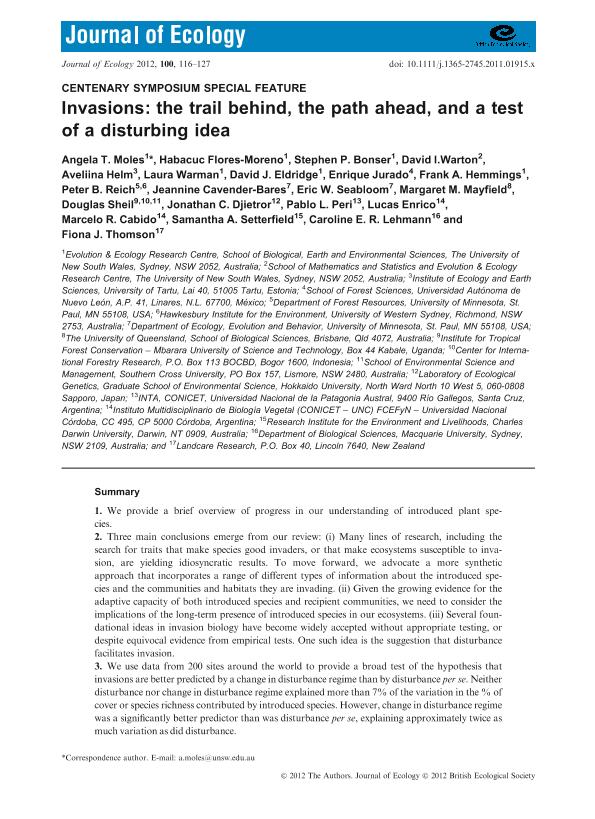Artículo
Invasions: the trail behind, the path ahead, and a test of a disturbing idea
Moles, Angela; Flores Moreno, Habacuc; Bonser, Stephen P.; Warton, David I.; Helm, Aveliina; Eldridge, David J.; Jurado, Enrique; Hemmings, Frank A.; Reich, Peter B.; Cavender Bares, Jeannine; Seabloom, Eric W.; Mayfield, Margaret M.; Sheil, Douglas; Djietror, Jonathan C.; Peri, Pablo Luis ; Enrico, Lucas
; Enrico, Lucas ; Cabido, Marcelo Ruben
; Cabido, Marcelo Ruben ; Setterfield, Samantha; Lehman, Caroline; Thomson, Fiona
; Setterfield, Samantha; Lehman, Caroline; Thomson, Fiona
 ; Enrico, Lucas
; Enrico, Lucas ; Cabido, Marcelo Ruben
; Cabido, Marcelo Ruben ; Setterfield, Samantha; Lehman, Caroline; Thomson, Fiona
; Setterfield, Samantha; Lehman, Caroline; Thomson, Fiona
Fecha de publicación:
01/2012
Editorial:
Wiley
Revista:
Journal Of Ecology
ISSN:
0022-0477
e-ISSN:
1365-2745
Idioma:
Inglés
Tipo de recurso:
Artículo publicado
Clasificación temática:
Resumen
We provide a brief overview of progress in our understanding of introduced plant species. Three main conclusions emerge from our review: (i) Many lines of research, including the search for traits that make species good invaders, or that make ecosystems susceptible to invasion, are yielding idiosyncratic results. To move forward, we advocate a more synthetic approach that incorporates a range of different types of information about the introduced species and the communities and habitats they are invading. (ii) Given the growing evidence for the adaptive capacity of both introduced species and recipient communities, we need to consider the implications of the long-term presence of introduced species in our ecosystems. (iii) Several foundational ideas in invasion biology have become widely accepted without appropriate testing, or despite equivocal evidence from empirical tests. One such idea is the suggestion that disturbance facilitates invasion. We use data from 200 sites around the world to provide a broad test of the hypothesis that invasions are better predicted by a change in disturbance regime than by disturbance per se. Neither disturbance nor change in disturbance regime explained more than 7% of the variation in the % of cover or species richness contributed by introduced species. However, change in disturbance regime was a significantly better predictor than was disturbance per se, explaining approximately twice as much variation as did disturbance.
Archivos asociados
Licencia
Identificadores
Colecciones
Articulos(IMBIV)
Articulos de INST.MULTIDISCIPL.DE BIOLOGIA VEGETAL (P)
Articulos de INST.MULTIDISCIPL.DE BIOLOGIA VEGETAL (P)
Articulos(SEDE CENTRAL)
Articulos de SEDE CENTRAL
Articulos de SEDE CENTRAL
Citación
Moles, Angela; Flores Moreno, Habacuc; Bonser, Stephen P.; Warton, David I.; Helm, Aveliina; et al.; Invasions: the trail behind, the path ahead, and a test of a disturbing idea; Wiley; Journal Of Ecology; 100; 1-2012; 116-127
Compartir
Altmétricas



